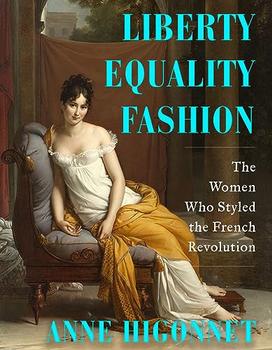Summary | Excerpt | Reviews | Beyond the Book | Readalikes | Genres & Themes | Author Bio

The Women Who Styled the French Revolution
by Anne Higonnet
When Joséphine left home and went to town, strolling through marketplaces or along the docks, she witnessed the most audacious styling of all. There, she encountered women in the third category established by the 1754 edict: the very light-skinned free women of color, who dared to invent an entirely new kind of women's clothing. Technically, the invention abided by the 1754 edict because it was made of cotton. It evaded sumptuary laws by being neither the privileged three-part gown nor the humble skirt-and-jacket combination. It was instead a one-piece dress called a gole, sometimes spelled gaulle. This dress dramatically replaced the fitted tops and bell-shaped skirts of conventional women's clothing with a straight silhouette from shoulder to ankle, while retaining the long, fitted sleeves of gown bodices. Made of fine, diaphanous cotton, a gole was always worn over a slip. Slips were sometimes white, sometimes pink, light blue, or peach. When worn over a pastel slip, the body of the white gole appeared delicately tinted. To keep them modest, these new gole dresses were also worn with big, sheer white cotton square scarves, folded diagonally, draped around the throat, and tucked in or tied.
Every detail of complete gole attire just barely slid by sumptuary restrictions, with substitutes for lace, precious embroideries, and passementerie. A cotton ruffle, for example, was embroidered white on white with cotton thread, to render it almost, but not quite, like lace. Exuberant cotton knots or bows replaced ribbons. Though gold and gems were banned, discretely small jewelry, "of little value," escaped censors.
Forced by law to innovate within the parameters of cotton, women of color in the Antilles fundamentally altered the history of fashion. Centuries of European sumptuary regulations had allocated rank to clothing according to the value of materials, but the women Joséphine grew up in the midst of had invented a fashion ecology independent of materials. Moreover, Antilles style allowed Joséphine to assume that anyone could design and construct their own clothes, because on the Antilles there were no guilds. Entrepreneurial tailors, of whom many were mixed race, could experiment without fear of guild reprisal. Elegance, Joséphine saw, could be achieved entirely through imaginative design.
Proud, light-skinned, mixed-race women in gole dresses dominated the style ecology of the islands. Trailed by male admirers or chatting with one another, accompanied by their own servants holding aloft brightly colored sunshades, they steered confidently through crowds of women in thick sturdy cotton skirts and blouses, whose more practical head-wraps and neck-scarves tended toward blue and red plaids, probably stained with the sweat of labor. The most elegant women in the Antilles, with their towering white head-wraps adorned with huge asymmetric bows and graceful fichu scarves swathing their throats, offered a mobile alternative to rigid mainland silhouettes.
How do we know what Joséphine saw? Luckily for us, one artist who made many small paintings on a nearby Caribbean island was fascinated by women's clothing. Agostino Brunias arrived on Dominica, located snugly between the French islands of Guadeloupe and Martinique, sometime between 1764 and 1770. When he arrived, Dominica had been British only since 1763, the year of Joséphine's birth. The sumptuary system Brunias encountered had been formed by French law. Brunias represented every nuance of cotton quality and accessories, while keying them to subtle differences in skin color, as if he were illustrating French sumptuary law. His paintings show us exactly what fashion Joséphine experienced until the age of sixteen.
However comfortable and strangely appealing straight white cotton gole dresses might have seemed to Joséphine, it was out of the question for her, as a White child on Martinique, to wear one outside the home, or on any formal occasion. White women in the Antilles knew it would be inconceivable for White women on the mainland of France to ever be seen in public in a gole. Glimpses might be caught of a few White women dressed in goles at home in the French port cities of Nantes, Lorient, or Bordeaux, where families in transatlantic trade clustered. Yet a gole was a serious fashion faux pas. It signaled Creole, and therefore social inferiority. To the mainland French, Creole meant anyone raised in the colonies.
Excerpted from Liberty Equality Fashion by Anne Higonnet. Copyright © 2024 by Anne Higonnet. Excerpted by permission of W.W. Norton & Company. All rights reserved. No part of this excerpt may be reproduced or reprinted without permission in writing from the publisher.
Your guide toexceptional books
BookBrowse seeks out and recommends the best in contemporary fiction and nonfiction—books that not only engage and entertain but also deepen our understanding of ourselves and the world around us.